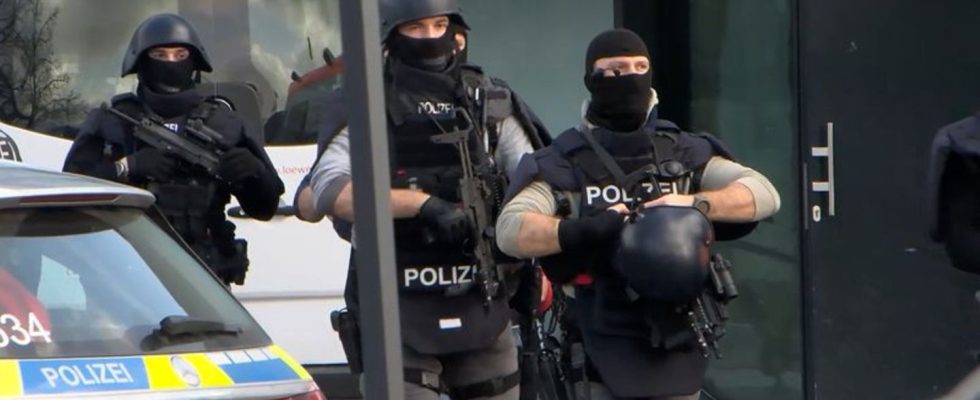A high school student is said to have killed a student with a knife. Experts determine whether such cases are increasing, what could be the reasons for violence – and who can take preventive action.
After the fatal knife attack on a student, the Heidelberg district court is to decide today whether the alleged perpetrator should be remanded in custody. An 18-year-old student from the same high school in St. Leon-Rot is suspected of having killed the victim of the same age with a knife on Thursday. Hours later he was arrested in Lower Saxony.
The student filed a criminal complaint against the accused in November for physical violence, as the public prosecutor and police announced. The investigators assume that it was a relationship, but initially did not give any details. They also did not initially disclose the nationality of the suspect.
Are such incidents becoming more frequent?
It is not the only such case in the recent past: In November, a 15-year-old German shot a fellow student of the same age at a special needs school in Offenburg.
However, such events are rare. “Of course every case is one too many,” said Klaus Seifried from the Professional Association of German Psychologists (BDP). “But if you compare Germany with the USA, Germany is absolutely peaceful.” And if you put the incidents in Offenburg and St. Leon-Rot in relation to millions of students, schools are just as peaceful. Teenagers and young adults who commit such acts are often lonely and have problems.
In his opinion, the inhibition threshold to use a weapon and kill someone has decreased as a result of computer games such as so-called first-person shooters. You learn to kill opponents with firearms. “Such games were developed to reduce the sensitivity of soldiers during combat operations,” explained Seifried. “This also happens with students.” Broad media coverage could also encourage people to “go down such an insane path.”
According to Seifried, parents should take time and ask how their children are doing. “Also for 15, 16, 17 year olds.” Many people don’t know what their children are doing on the computer or what worries they have.
School life is an important factor in prevention
According to Prof. Sibylle Winter, violence among children and young people has increased, not least as a result of the corona pandemic. This is very rarely shown in the most serious violence such as the two homicides in Baden-Württemberg, said the deputy clinic director and senior physician at the Clinic for Psychiatry, Psychosomatics and Psychotherapy of Children and Adolescents at the Berlin Charité. “But there is more emotional violence. There is more screaming, more insults.” Bullying, for example, is increasing.
The expert cited, among other things, the lockdowns with closed schools and so-called homeschooling as the reason. “Corona has knocked people out for three years,” said Winter. Above all, at school, you acquire social skills when you work together. “You don’t learn that by sitting alone in front of the computer.” That’s why it’s important to be together at school.
Especially 15-year-olds like the alleged perpetrator in Offenburg and 18-year-olds like the suspect in St. Leon-Rot are in an age range in which important steps are taken – from pubescent, sometimes rebellious teenagers to adults. “We shouldn’t underestimate that.” The environment such as parents and school as possible contacts also played a role here.
School can be a stabilizing factor, especially when the circumstances at home may not be so, said Seifried, who is also second chairman of the school psychology section in the BDP. “School is not just a place for imparting knowledge, but above all a place for social interaction.” There is less violence in schools that value a good classroom and school climate than in those where there is anonymity, competition and pressure to perform. Performance would also improve if a good school climate, relationship building and participation were promoted.
“Nevertheless, we cannot prevent such acts”
Classmates are an important early warning system, said the psychologist. They would know if someone was drifting away, if someone wasn’t doing well. That comes with a lot of responsibility. Some schools train dispute mediators or conflict pilots who would then have sufficient sensitivity and competence. If the police need to be involved, adults should do so.
Winter thinks it is important that schools establish protection concepts. This includes a code of conduct that sets out rules of behavior such as mutual respect and refraining from violence.
“Nevertheless, we cannot prevent such acts,” said Seifried. “If someone grows up where violence is used as a method of conflict resolution, schools can only take compensatory action to a limited extent.” From a therapeutic perspective, according to Winter, it also makes a difference whether a perpetrator becomes aggressive out of frustration or grew up through violence. “Those who have learned to solve problems with aggression are more difficult to reach therapeutically.”

